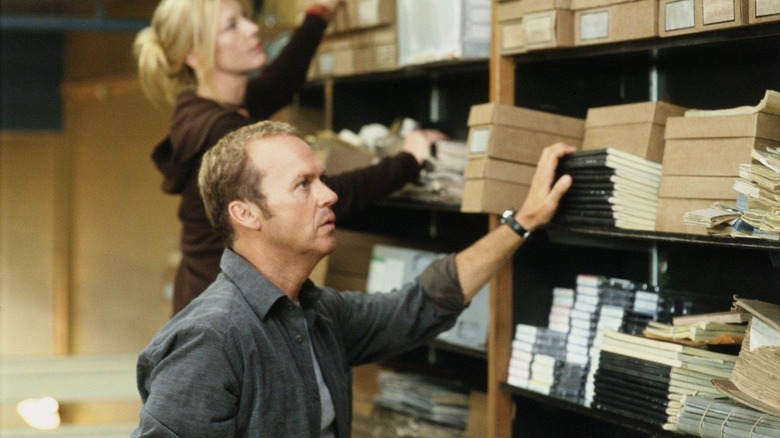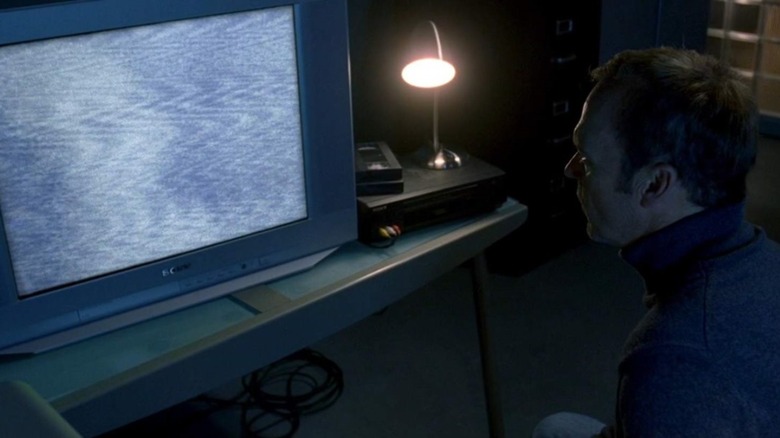Universal Pictures
Geoffrey Sax’s 2005 thriller, “White Noise,” features Michael Keaton as Jonathan Rivers, an architect. He lives a blissful marital life with his second wife, Anna (Chandra West). However, one day Anna fails to return home and remains missing for five months. During this time, Jonathan is contacted by a man named Raymond (Ian McNeice), who claims to have information about Anna’s location. Raymond has been observing static-tuned TVs and listening to garbled radio signals, and he believes he can hear voices emerging from the static, which he thinks are the voices of ghosts communicating with the living world.
Though initially skeptical, Jonathan eventually succumbs to the allure of white noise monitoring. However, his actions disturb the inhabitants of the spirit world, leading to a series of eerie and violent occurrences. The film concludes on a grim note, with a chyron stating that “Of the many thousands of documented EVP messages, approximately 1 in 12 have been overtly threatening in nature…”
The Fear Induced by Outdated Technology

Universal Pictures
“White Noise” is a prime example of horror films’ obsession with antiquated technology. The film suggests that older tech, built before technological advancements, is more susceptible to paranormal infiltration. The movie implies that modern radios are too sophisticated to receive signals from ghosts or demons, while a radio from the 1910s, with its vintage aura, seems eerie, distant, and capable of something peculiar.
This concept is not new and has been portrayed in films like “The Ring” and “Spiral” (2019), where VHS cassettes play a significant role. “White Noise” delves into the ‘snow’ of a cathode ray tube TV, revealing spirits hidden in the abstract shimmering. This concept, while familiar to fans of paranormal phenomena, was well-presented by director Sax.
Mixed Reviews

Universal Pictures
Despite its atmospheric intensity, “White Noise” received mixed reviews. William Thomas, writing for Empire, criticized the film for its thin script. He wrote, “The soundtrack and crackling static, contorting into mysterious moans, create a chilling mood, but the characters are so thin we never understand why Keaton would abandon his life for the paranormal.”
However, not all reviews were negative. Stephanie Zacharek, writing for Salon, commended the film’s eerie mood. She acknowledged its flaws but praised its ability to build up to something genuinely frightening. Zacharek wrote:
“It has plenty of problems — chief among them, the fact that the end doesn’t make much sense, and the first half crawls along on arty little ghost feet. But toward the second half, “White Noise” turns into something the first half doesn’t quite prepare you for — the movie takes on a dry, creepy sheen. Even if its dorky climax throws you out of the mood again, there are staticky bits of ‘White Noise’ that still manage to cling.”
Ultimately, the impact of “White Noise” varies depending on the viewer’s fear of eerie TV static. Many have grown up with CRT tubes and have experienced the sensation of staring into the static in a dark room, convinced that something is staring back. Skeptics may dismiss the premise of “White Noise” as paranormal nonsense. As a viewer who has been terrified by a sudden voice emerging from an untuned TV, “White Noise” had a certain unsettling effect on me. While it’s not perfect and the story is somewhat silly, it does achieve what every horror movie should: it’s scary.
Credit: www.slashfilm.com


